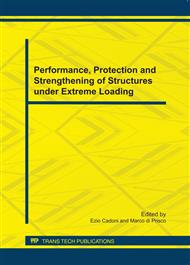p.302
p.308
p.314
p.320
p.326
p.332
p.338
p.344
p.350
Experimental and Analytical Evaluation of Progressive Collapse Resistance of a Full-Scale Structure Following Sever Loss of Load Bearing Elements
Abstract:
Experimental and analytical studies are carried out to evaluate the response of an actual reinforced concrete structure following severe initial damage, which was caused in part by simultaneous explosion (removal) of four adjacent columns. In addition, two beam segments in the vicinity of the removed columns were also exploded. The structure resisted progressive collapse following such severe initial damage. The progressive collapse resisting mechanisms primarily included the axial-flexural action of the second floor deep beams and Vierendeel action of the flat plate system in floors above. In the analytical studies, a nonlinear model of the structure is used, which accounts for axial-flexural interaction of beams and slabs. The analytical results show good agreement with experimental data.
Info:
Periodical:
Pages:
326-331
Citation:
Online since:
July 2011
Authors:
Price:
Сopyright:
© 2011 Trans Tech Publications Ltd. All Rights Reserved
Share:
Citation:


